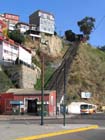 |
 |
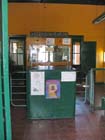 |
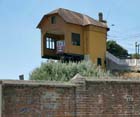 |
| Artilleria1.jpg | Artilleria2.jpg | Baron1.jpg | Baron2.jpg |
 |
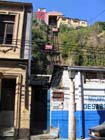 |
 |
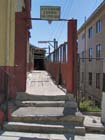 |
| Baron3.jpg | EspirituSanto1.jpg | EspirituSanto2.jpg | LosLecheros.jpg |
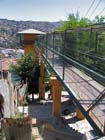 |
|||
| Polanco.jpg |
| Valparaiso Ascensores
Don and Lois Porter 1/12/2005 |
Beginning in the 1880s, Valparaiso added new residential areas on the many hills rising from the limited flat plain that forms the port and central city. Our map identifies 27 "Hills (Cerros) of Valparaiso". Funicular lifts, or "ascensores" were built to move pedestrians between the lower town and many of the hills. Most were built between 1886 and 1916. They seem to have been carefully maintained using the exact same techniques with which they were built, resulting in rickety antiques that work consistently year after year. Most of them cost 100 pesos (about 15 US cents) to ride, but some cost 100 pesos to descend, and 120 pesos to ascend. All but one of the fifteen remaining ascensores operate on train tracks, with cables that link an upward-bound car to a downward-bound car, passing around a large pulley wheel at the top -- so that each car counterweights the other. The ride up or down usually takes about 1 to 2 minutes. One of the ascensores, Ascensor Polanco, is actually an elevator, starting underground (reached by a tunnel) and ending at the top of a tower, a 100 feet or so above ground. Then you walk over a narrow footbridge to Cerro Polanco (Polanco Hill).
Ascensor Baron was built in 1906, the first to be powered by an electric motor -- still in perfect working order. At the bottom, it leaves you in a mess of construction. It appears that major municipal, commercial, and industrial parts of Valparaiso are being rebuilt. The port is a complete mess of construction. One result is that Ascensor Villaseca is accessible only by detouring around the works where they are building a railway tunnel to access the port.
Ascensor Artilleria climbs from the Aduana plaza, the hub of the port area of town, up the Artilleria Hill to our home neighborhood. Right at the top is the viewpoint 21 de Mayo, a favorite place to look out at the city and the port and bay. It was built in 1893 to transport cadets to and from the naval school at the top of the hill, now the site of the Naval Museum.
Many of the ascensores have very modest entrances, top and bottom, such as Espiritu Santo and Los Lecheros (pictured). In fact, until we learned how to look for them, we missed several entrances by walking right by them.
Chileans are proud of Valparaiso's designation in 2003 by UNESCO as one of the "World Heritage Sites". Certainly the ascensores were notable features that contributed to that selection. They are amazing, kind of like San Francisco's trolleys. Feels like riding a steam-age contraption, but they're still totally practical and heavily used. We enjoy riding them!
 |
 |
 |
 |
| Artilleria1.jpg | Artilleria2.jpg | Baron1.jpg | Baron2.jpg |
 |
 |
 |
 |
| Baron3.jpg | EspirituSanto1.jpg | EspirituSanto2.jpg | LosLecheros.jpg |
 |
|||
| Polanco.jpg |